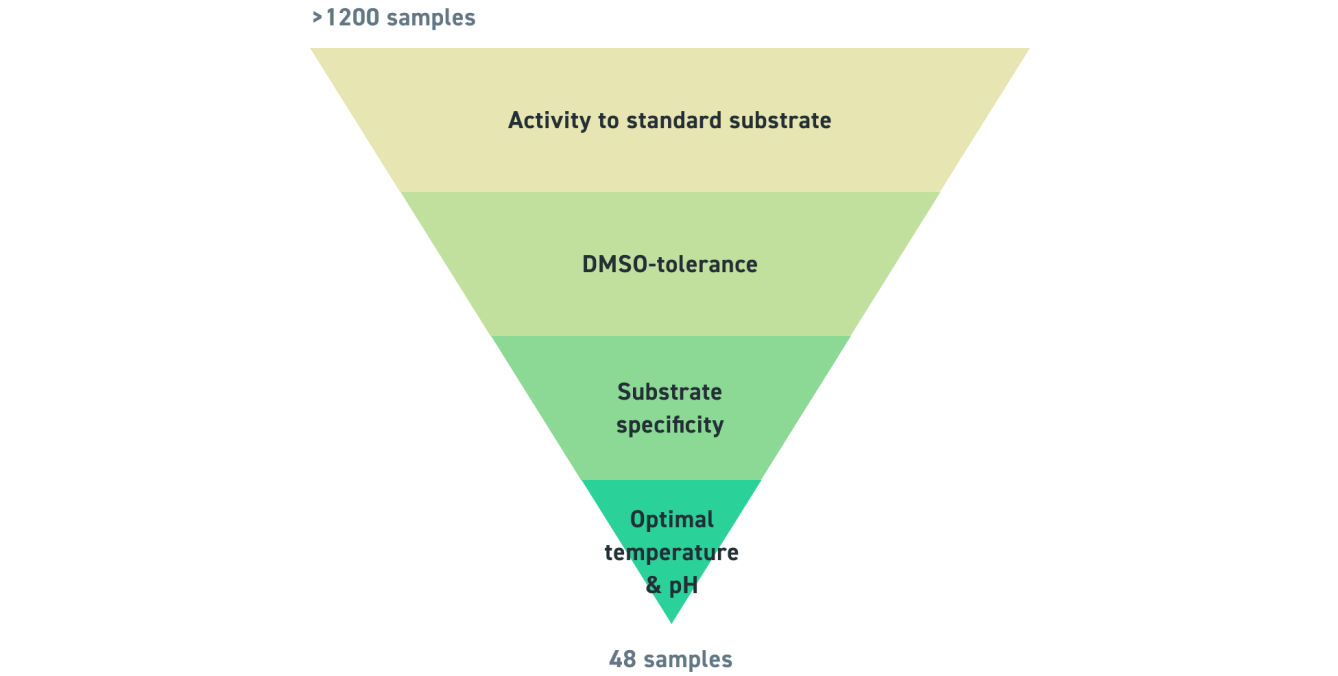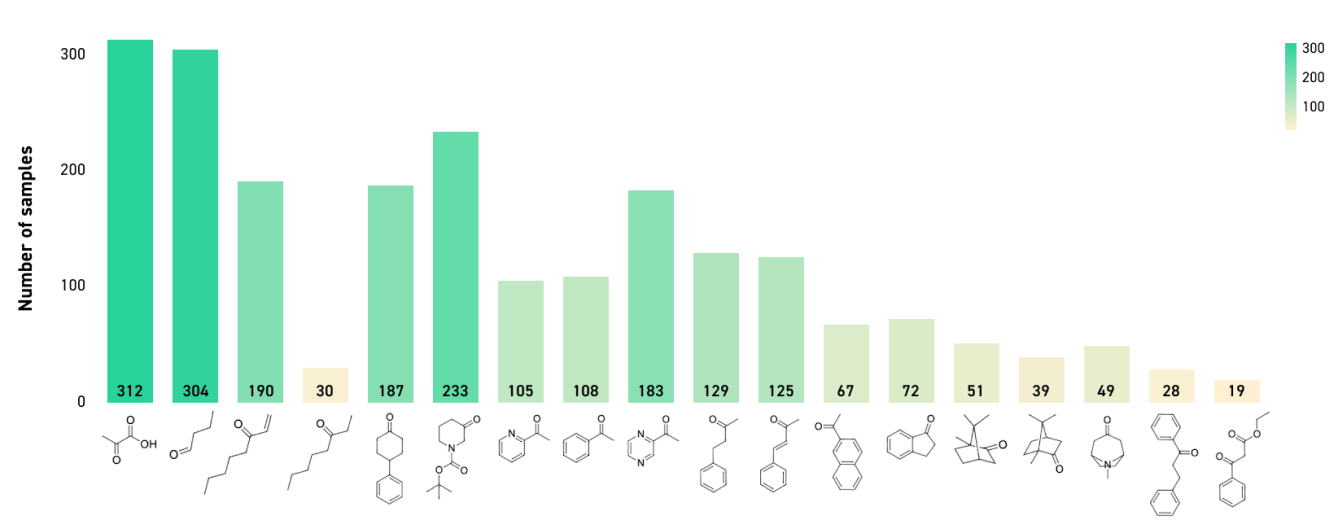Unlock untapped enzyme sequence space to enable optimal exploration
Our novel enzyme sequences have been identified from diverse uncultured microbial single-cell genomes and have been selected for desirable properties using ML-assisted models based on structure prediction, structure-based clustering and filtering - you likely will not find these sequences anywhere else.
Transaminases (TAs) are enzymes that catalyze the transfer of an amine group from an amine donor to a ketone or aldehyde. This ability to facilitate the stereoselective amination of prochiral ketones is valuable in pharmaceutical manufacturing, where the demand for chiral amines as building blocks for active pharmaceutical ingredients (APIs) is high.
We have identified and narrowed down a subset of TA enzymes that maintain activity in a variety of extreme conditions across many diverse substrates, useful for the pharmaceutical manufacturing process.
Our screening kit enables the selection of functionally relevant sequences with the future possibility of combining these with downstream enzyme engineering resources to provide a more efficient pathway for protein engineering.
How enzymes are selected for screening
The bitBiome bit-GEM database is the leading resource for searchable and highly usable microbe genome sequences. Drawing on nature’s most potent microbial resources including samples from environments like soil, hotsprings, marine water, mining sites, and other extreme conditions, the bit-GEM database contains a vast array of gene sequences acquired by the bitBiome single-cell sequencing platform. This sequencing method ensures deeper genome coverage, allowing for the discovery of microbial “dark matter”. These sequences have low similarity to those in the public realm, giving the customer the freedom to operate within that sequence space.



Unlock untapped enzyme sequence space to enable optimal exploration
Our novel enzyme sequences have been identified from diverse uncultured microbial single-cell genomes and have been selected for desirable properties using ML-assisted models based on structure prediction, structure-based clustering and filtering - you likely will not find these sequences anywhere else.
Transaminases (TAs) are enzymes that catalyze the transfer of an amine group from an amine donor to a ketone or aldehyde. This ability to facilitate the stereoselective amination of prochiral ketones is valuable in pharmaceutical manufacturing, where the demand for chiral amines as building blocks for active pharmaceutical ingredients (APIs) is high.
We have identified and narrowed down a subset of TA enzymes that maintain activity in a variety of extreme conditions across many diverse substrates, useful for the pharmaceutical manufacturing process.
Our screening kit enables the selection of functionally relevant sequences with the future possibility of combining these with downstream enzyme engineering resources to provide a more efficient pathway for protein engineering.
How enzymes are selected for screening
The bitBiome bit-GEM database is the leading resource for searchable and highly usable microbe genome sequences. Drawing on nature’s most potent microbial resources including samples from environments like soil, hotsprings, marine water, mining sites, and other extreme conditions, the bit-GEM database contains a vast array of gene sequences acquired by the bitBiome single-cell sequencing platform. This sequencing method ensures deeper genome coverage, allowing for the discovery of microbial “dark matter”. These sequences have low similarity to those in the public realm, giving the customer the freedom to operate within that sequence space.



How Enzymes Are Selected For Screening
Drawing on nature’s potent microbial resources including samples from environments like soil, hotsprings, marine water, mining sites, and other extreme conditions, the bit-GEM database contains a vast array of gene sequences acquired by the bitBiome single-cell sequencing platform. This sequencing method ensures deeper genome coverage, allowing for the discovery of microbial “dark matter”. These sequences have low similarity to those in the public realm, providing better freedom to operate within that sequence space. The selection of the 48 enzymes provided in this kit was powered not only by Twist DNA synthesis capabilities but also a collaborative bioinformatics effort to refine the functional sequence space.
How Enzymes Were Selected For Our Kit
A total of 369 active transaminases were identified with 19 substrates. 273 of the enzymes were found to be active in 10% DMSO with 30 active at 60°C. Finally, the enzymes were tested for pH sensitivity and selectivity.
Criteria for Transaminase Screening

Below is a breakdown of the enzymes tested against various substrates in the varying conditions previously described (various % of DMSO, organic solvents, temperatures, and pH levels).

How Enzymes Are Selected For Screening
Drawing on nature’s potent microbial resources including samples from environments like soil, hotsprings, marine water, mining sites, and other extreme conditions, the bit-GEM database contains a vast array of gene sequences acquired by the bitBiome single-cell sequencing platform. This sequencing method ensures deeper genome coverage, allowing for the discovery of microbial “dark matter”. These sequences have low similarity to those in the public realm, providing better freedom to operate within that sequence space. The selection of the 48 enzymes provided in this kit was powered not only by Twist DNA synthesis capabilities but also a collaborative bioinformatics effort to refine the functional sequence space.
How Enzymes Were Selected For Our Kit
A total of 369 active transaminases were identified with 19 substrates. 273 of the enzymes were found to be active in 10% DMSO with 30 active at 60°C. Finally, the enzymes were tested for pH sensitivity and selectivity.
Criteria for Transaminase Screening

Below is a breakdown of the enzymes tested against various substrates in the varying conditions previously described (various % of DMSO, organic solvents, temperatures, and pH levels).
